10 Biggest Waterfalls in the World (Tallest, Widest, & Most Volume!)


Few things in nature stir our senses like falling water. Whether it’s a gently babbling trickle or a raging torrent tumbling down the side of a mountain, waterfalls are truly one of nature’s gifts.
However, this article is only interested in the latter sort of waterfall - the ones that inspire awe, wonder, and a sense of majesty. Some, like Niagara Falls, are world-famous while others are so inaccessible that few humans have ever seen them up close. Keep reading to discover the biggest waterfalls in the world.
How To Measure Waterfalls
Search for the largest waterfalls in the world and you won’t come away with a definitive answer. There are a couple of reasons for this.
Firstly, it’s very difficult to accurately measure huge waterfalls as they’re dangerous and often almost impossible to access. Furthermore, there’s often debate about the start and end point for waterfalls, particularly shallower ones involving lots of rapids.
Also, the term "biggest" can mean different things. It can be used to refer to the height, width, or volume (usually calculated by the amount of water that passes over the falls, measured in cubic feet, cubic meters, liters, or gallons per second).
What’s more, lists of the world’s tallest waterfalls can vary because of differences in what’s actually being measured. Most waterfalls consist of several ‘drops’. Some lists look at the total decrease in elevation (total height), while others measure the longest single, uninterrupted drop. In this article, we’ll use the total height.
So without further ado, let’s see the colossal cascades. We’ll show you the 5 highest and the 5 widest waterfalls in the world.
1. Tallest Waterfall: Angel Falls (Kerepakupai-merú in Local Languages)
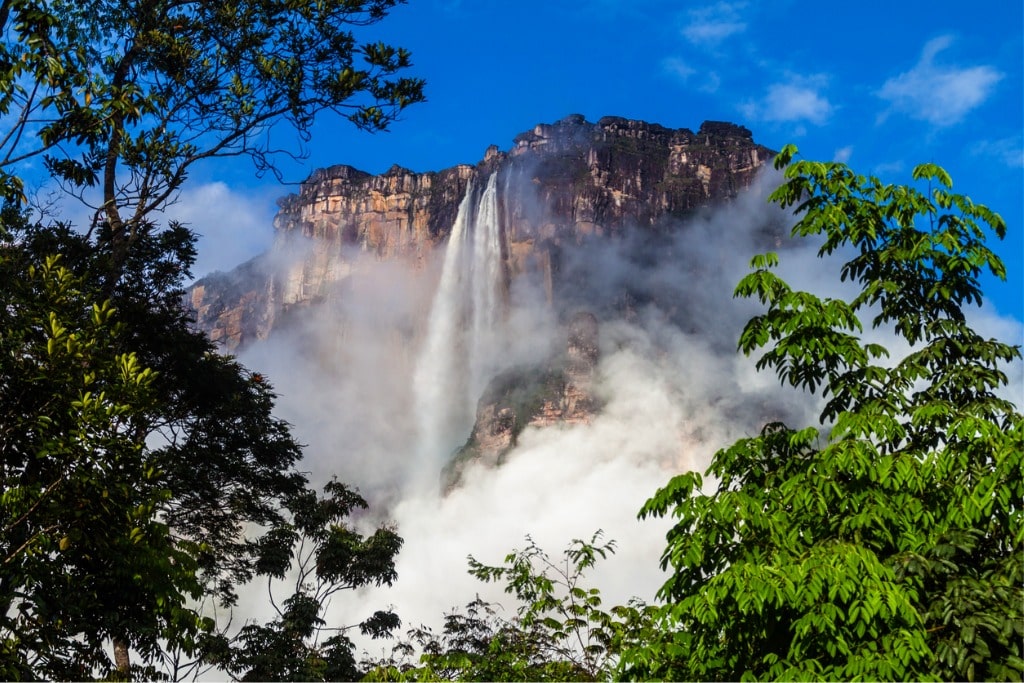
Location: Canaima National Park, Bolivar, Venezuela, South America
Height: 3,212 feet or 979 meters Volume: Up to 4 cubic meters per second
Angel Falls is special for many reasons. Not only is it the highest waterfall in the world by most measurements, but it also boasts the highest single drop. Water falls uninterrupted for a staggering 807m. From this height, the water plummets with such force that it becomes mist before finishing its plunge.
Reaching the falls, a UNESCO World Heritage Site since 1994, requires hours of boating along rivers and trekking through forests led by local guides. The falls have an element of mystique. It falls down the wall of a mountain known as Auyán-tepui (Devil’s Mountain), and the summit is often shrouded in clouds.
Unusually, the clouds are the source of the waterfall, rather than a river or meltwater as is often the case. Therefore the appearance of the falls frequently varies depending on the level of rainfall these clouds release, and in the dry season, it becomes little more than a trickle.
2. Second-Tallest Waterfall: Tugela Falls
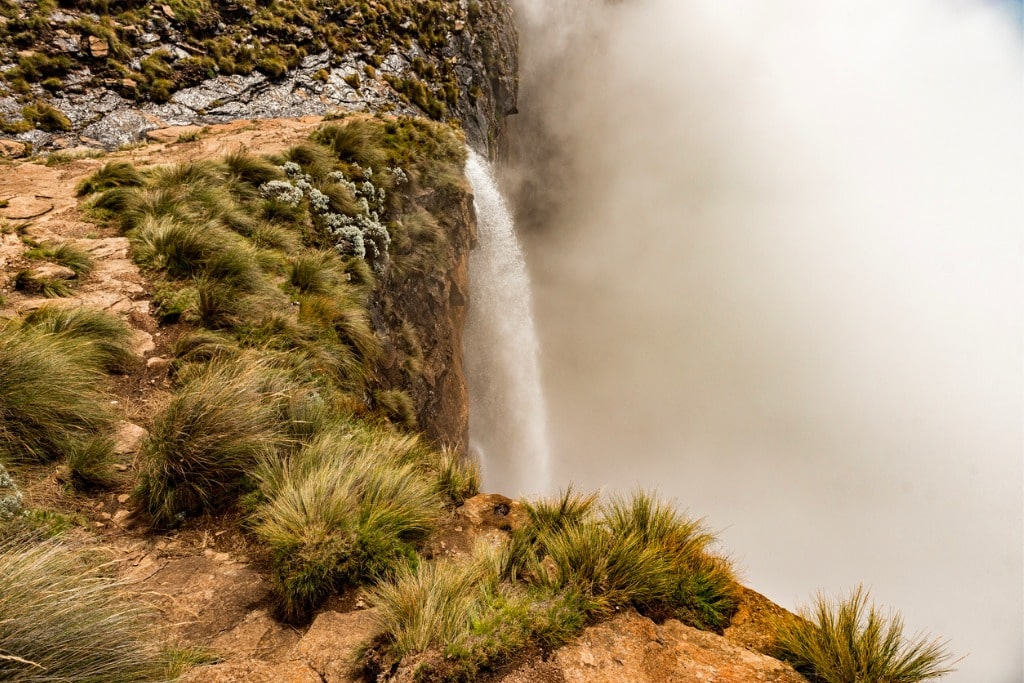
Location: Royal Natal National Park, KwaZulu-Natal, South Africa, Africa
Height: 3,110 feet or 948 meters Volume: Unknown (low volume with seasonal variability)
While not far off Angel Falls in height, Tugela Falls differs greatly in other ways. Named after the river it’s part of, the falls consist of five main drops, the longest of which is 411m.
The falls flow down a vast, curving wall of rock known as the Amphitheater, and the quickest way to reach the top involves a terrifying climb up sheer cliffs using chain ladders.
There is debate among geologists about whether Tugela Falls is actually the tallest in the world, citing inaccuracies in the measurements of both Tugela and Angel Falls.
3. Third-Tallest Waterfall: Tres Hermanas
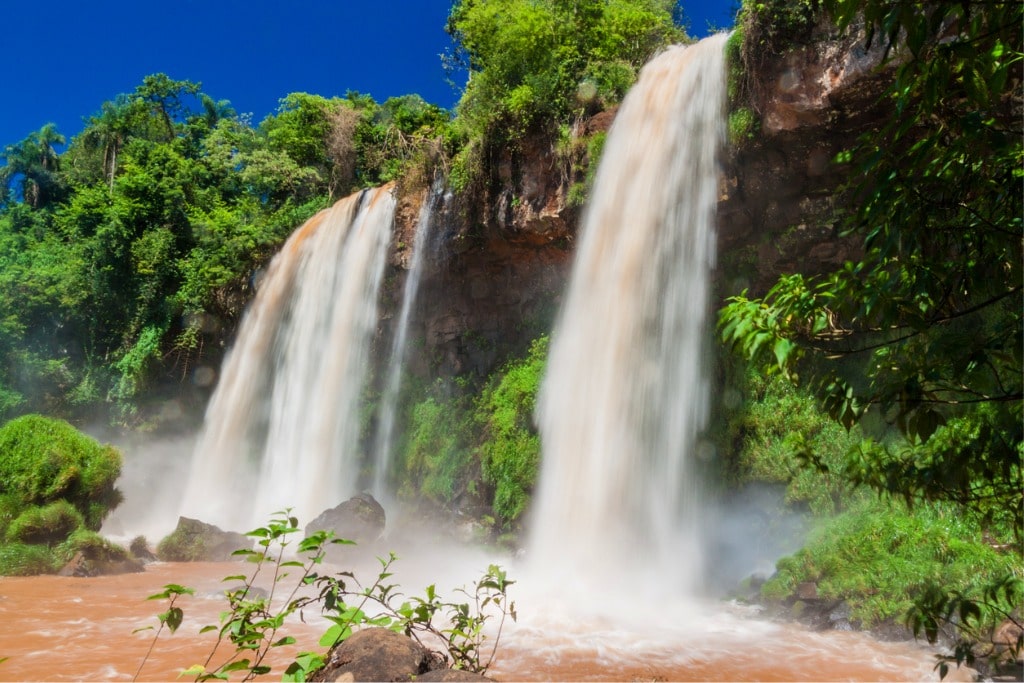
Location: Otishi National Park, Junin Region, Peru, South America
Height: 2,998 feet or 914 meters Volume: Up to 1 cubic meter per second
Peru contains several huge and spectacular waterfalls, including Gocta and Yumbilla. While both of these are relatively easy to access and attract more visitors, Tres Hermanas remains fairly unknown and is rarely visited because the terrain is so inaccessible.
The name means "Three Sisters" in Spanish - as the waterfall cuts through the densely forested mountain, it drops in three stunning sections before entering the Cutivereni River.
4. Fourth-Tallest Waterfall: Olo'upena Falls
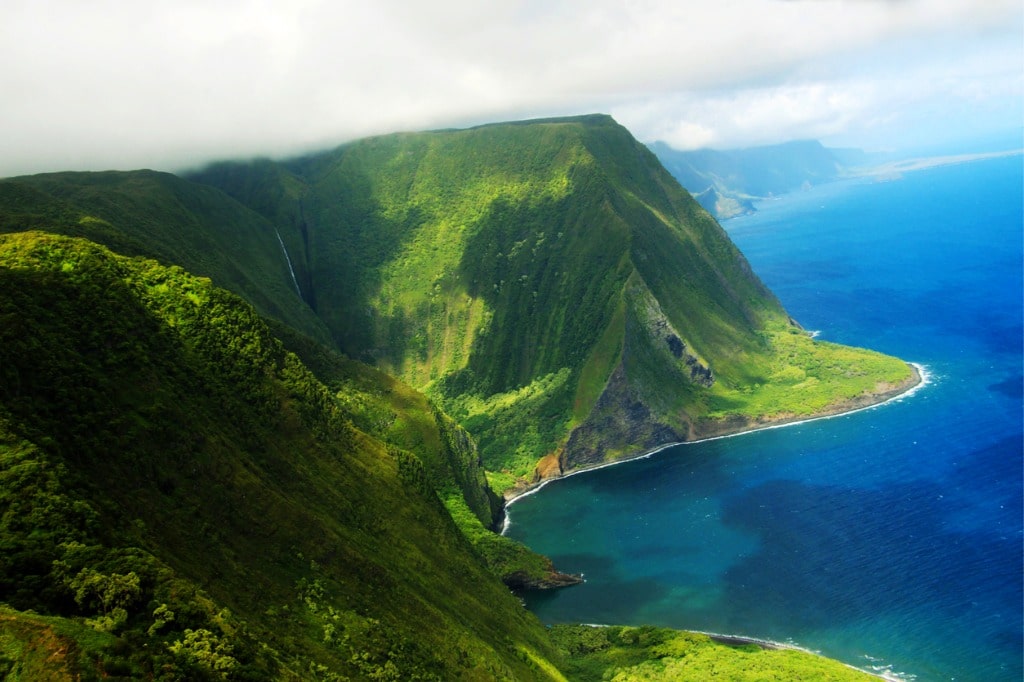
Location: Molokai Island, Hawaii, USA, North America
Height: 2,952 feet or 900 meters Volume: Unknown
Another waterfall that’s almost impossible to access. The volcanic island of Molokai is home to the largest sea cliffs in the world. Several of the world’s highest waterfalls occur here, the tallest of which is Olo’upena Falls. During the rainy season, thin white ribbons of water stream down the near-vertical, emerald green cliffs in grooves carved out over millennia.
Plunging straight into the Pacific Ocean, Olo’upena Falls can only be seen from the air or sea.
5. Fifth-Tallest Waterfall: Yumbilla Falls
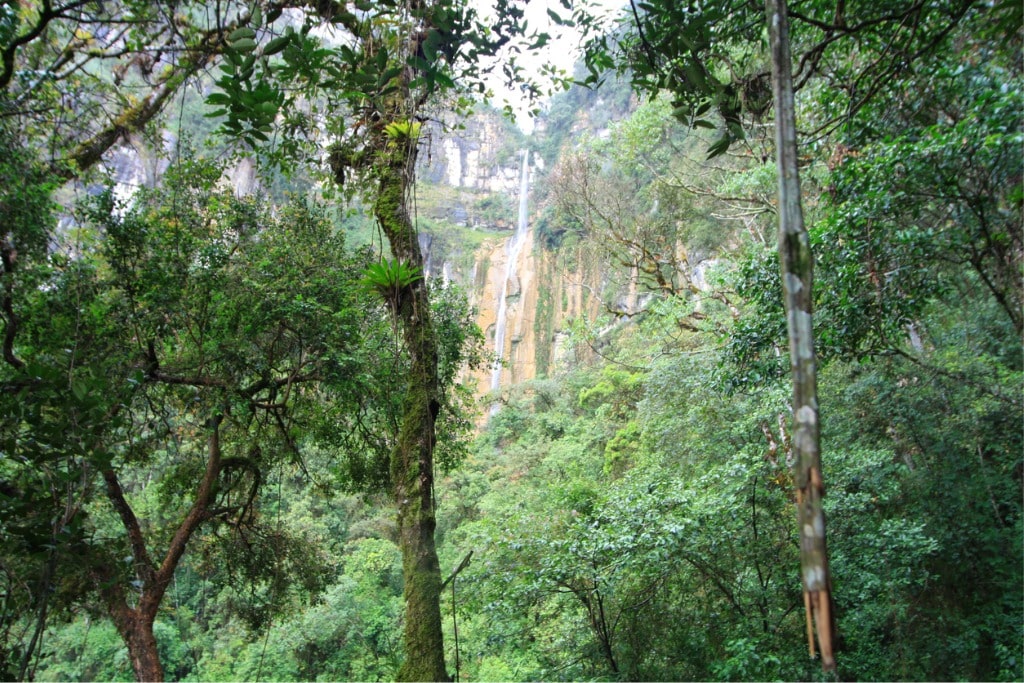
Location: Cuispes, Amazonas, Peru, South America
Height: 2,939 feet or 896 meters Volume: Unknown, but low volume
In a region renowned for beautiful waterfalls, this colossus remains surprisingly obscure. Most visitors to the region head to the nearby Gocta Waterfall, a less lofty but more famous tourist attraction.
However, getting to Yumbilla Falls is still a relatively easy and very scenic hike, and the reward is well worth the effort as the water plunges through five dramatic sections.
Yumbilla wraps up our top 5 tallest waterfalls. Now it’s time to look at the 5 widest waterfalls. They may not inspire us with the heavenly heights of the tallest waterfalls, but they certainly have the ability to awe us through the noise and sheer power of the incredible volume of water that passes over them.
6. The Widest Waterfall: Khone Phapheng Falls
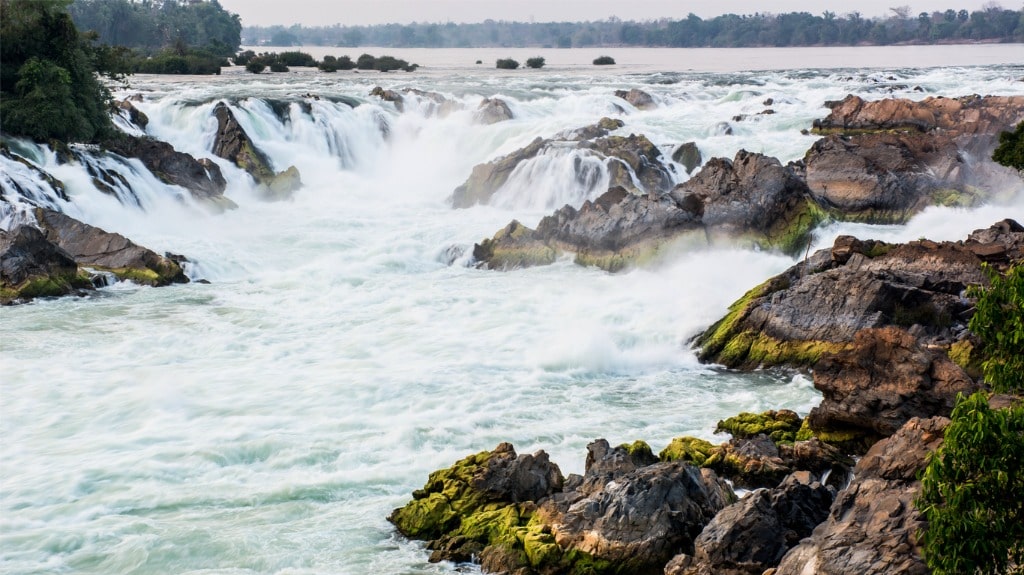
Location: Ban Hang Khone, Laos, Southeast Asia
Width: 35,672 feet or 10,873 meters Volume: 11,000 cubic meters per second (average)
The vast breadth of these falls is caused by the splitting of the mighty Mekong river into seven channels. When measured side-by-side, they reach almost 11km, making it the world’s widest waterfall
The falls are not particularly high, with the tallest drop around 20 meters, and large parts of the falls appear more like a series of rapids. These falls prevent navigation along the Mekong into China, and are such a significant barrier that the river before the falls is known as the ‘upper’ part and the river after the falls is called the ‘lower’ part.
7. Second-Widest Waterfall: Para Falls
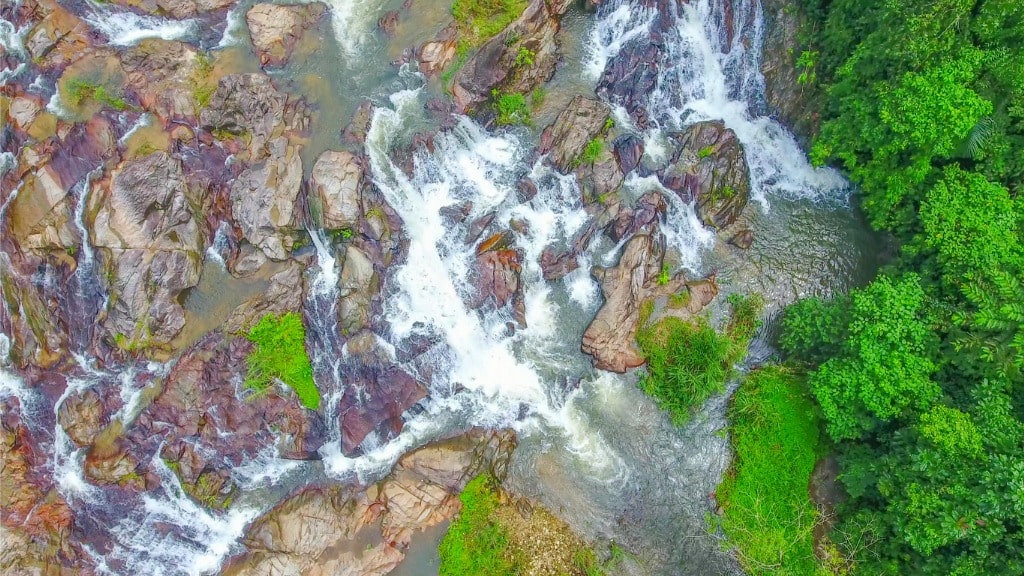
Location: Bolivar, Venezuela, South America
Width: 18,398 feet or 5,608 meters Volume: 3,540 cubic meters per second
Though just over half the width of the Khone Phapheng Falls, Para Falls still makes for a very impressive site for those who make the treacherous journey.
The falls appear as the Cauro river, a tributary of the great Orinoco, splits into two streams on either side of an island around 8 miles long. Cutting through gorges on each side, they then reconverge in a vast, horseshoe fall to create a truly sensational sight.
8. Third-Widest Waterfall: Kongou Falls
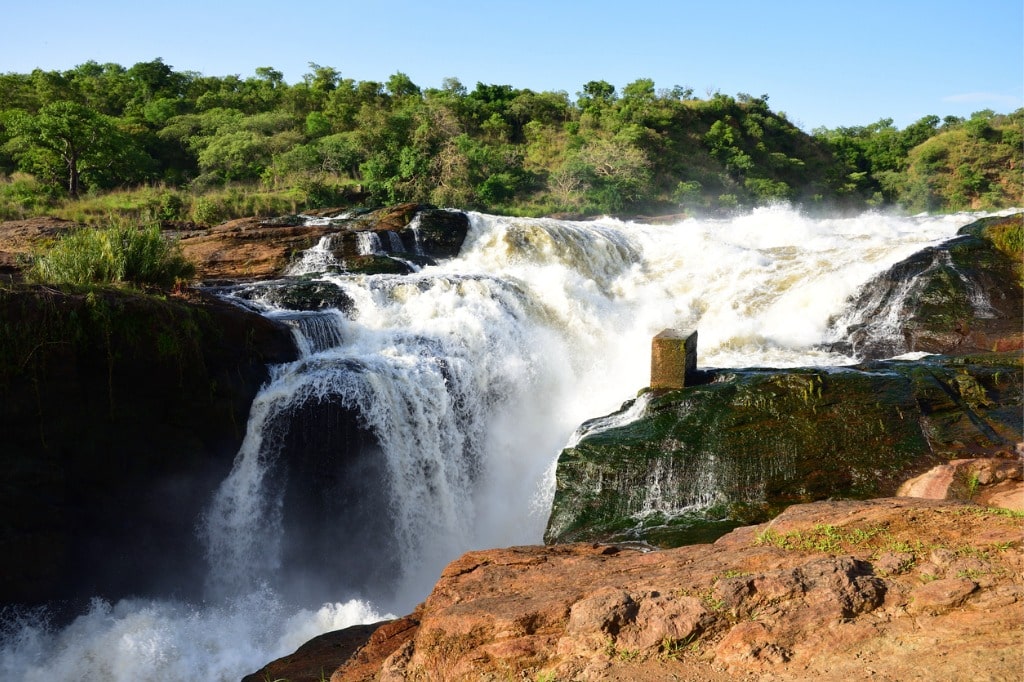
Location: Ivindo National Park, Ogooue-Ivindo Province, Gabon, Central Africa
Width: 10,498 feet or 3,200 meters Volume: 900 cubic meters per second
Mention waterfalls in Africa and you may think of Zimbabwe’s Victoria Falls, a Natural Wonder and more famous waterfall than Kongou. However, Kongou is almost double the width of Victoria Falls and is considered by some to be the strongest-flowing waterfall in the world. Nowhere is its power better demonstrated than a section with two mighty cataracts known as the ‘Sun’ and ‘Moon’.
Mother Nature’s force is on full display here, with deep brown water gushing relentlessly over the falls to crash into the gorge below. From the town of Mokokou, local guides can lead adventurers to the falls via canoe and trails through the gloriously unspoiled jungle.
Sadly the area’s natural beauty and biodiversity are under threat as developers have long been interested in damming the falls to provide power for mining. Thankfully, fierce opposition from the Gabonese people has so far held these plans at bay.
9. Fourth-Widest Waterfall: Iguazú Falls
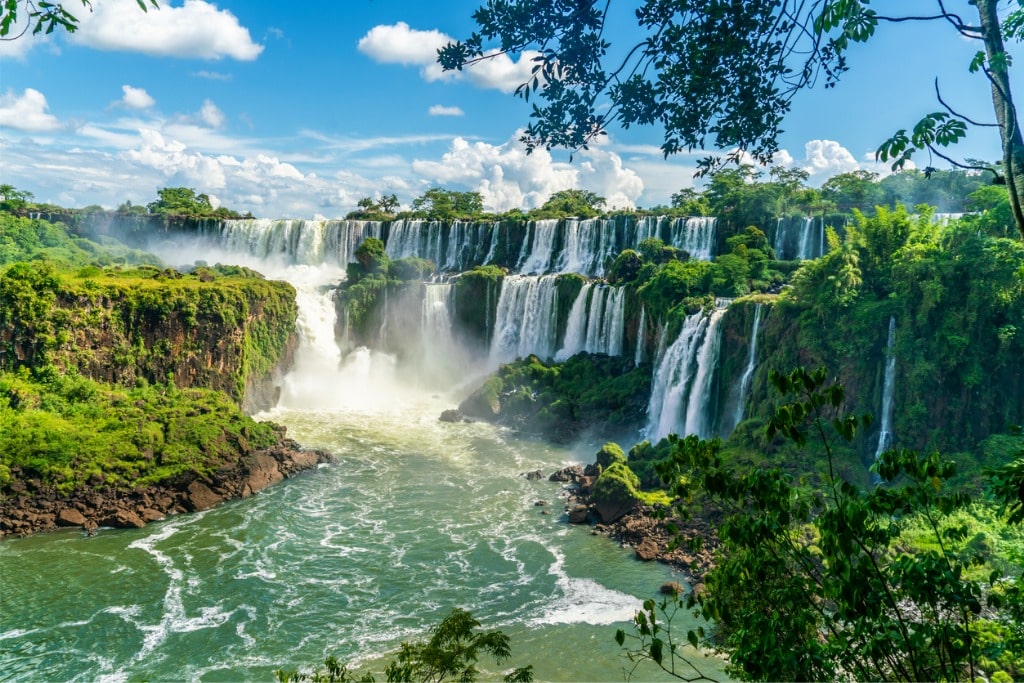
Location: Parana, Argentina, South America
Width: 8,858 feet or 2,700 meters Volume: 1,746 cubic meters per second
Dwarfing the Niagara Falls is no mean feat, but this jaw-dropping waterfall straddling Argentina and Brazil unquestionably achieves this.
Just before reaching the falls, the Iguazú river sprawls across a vast, flat shelf. A large portion of this water then tumbles from all sides into a narrow, horseshoe-shaped gorge known as "Devil’s Throat".
Unlike the three widest waterfalls, Iguazú (or Iguaçu on the Brazilian side) Falls is a hugely popular tourist attraction. It’s easily accessed from nearby towns and walkways provide prime vantage points to see right down the Devil’s Throat - words simply can’t describe the view that awaits visitors.
10. Fifth-Widest Waterfall: Mocona Falls
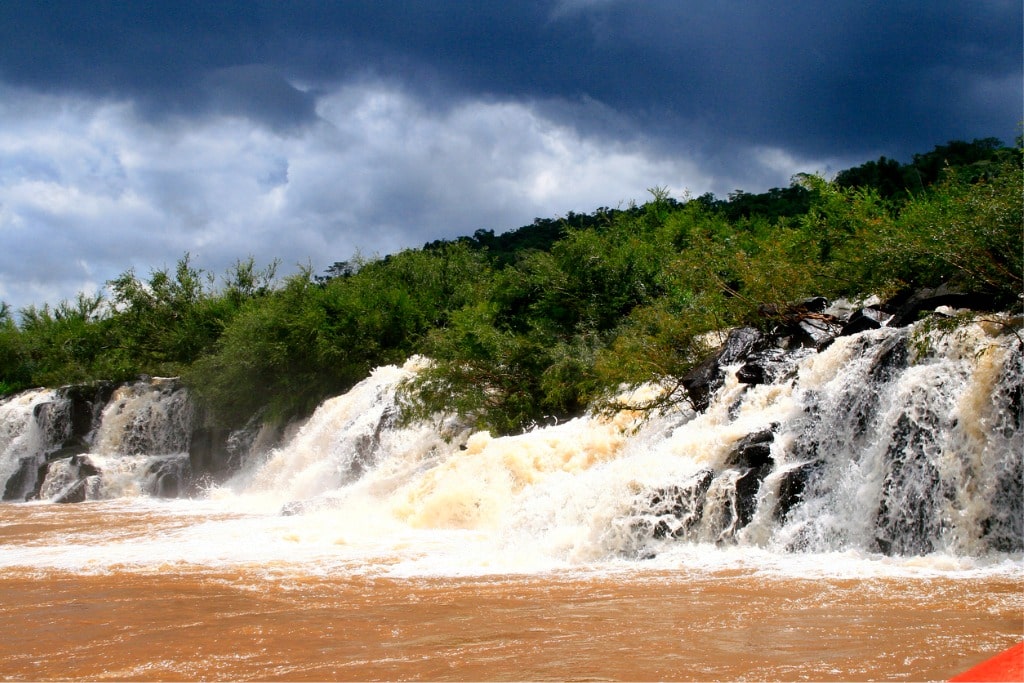
Location: Misiones, Argentina, South America
Width: 6,774 feet or 2,065 meters Volume: Unknown (variable)
Due to a geological quirk, this waterfall on the border between Argentina and Uruguay has the unique characteristic of running parallel to its river, rather than across it.
A fault line along the bed of the Uruguay River means that half of the river is lower than the other. When the water level is low enough, water cascades from one side to the other for over 2km.
However, you need to time it right to see it - depending on the rainfall, the height of the falls varies. In fact, for almost half the year, they disappear as high rainfall raises the water on both sides above the height of the falls.
Don't Go Chasing Waterfalls
That wraps up our journey around the world’s biggest and best waterfalls. While many of the falls on our list are in very remote locations, there are plenty of other places around the world where you can see these wonders of nature.
Norway has many towering falls among its fjords, as does Fjordland in New Zealand. Yosemite National Park is also famous for its gigantic cataracts, and Africa’s Congo and Zambezi Rivers are home to several mighty cascades.
Interesting Caves and Caverns of the WorldAbout the author







